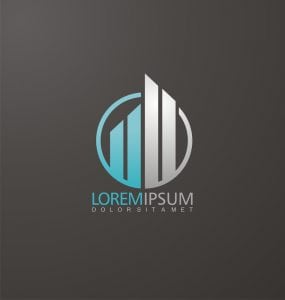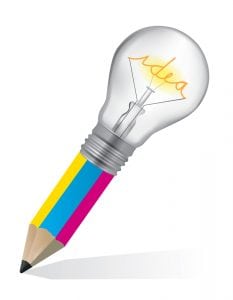Thinking of DIY logo design to save a few cents? Well, hiring a designer to create a logo for your company is essential, and yet some business owners insist on trying to do it themselves, even if they have no graphic design experience.
What a Logo is Supposed to Do
What should a company logo do? A logo should be much more than simply an image to fill in space on your business card or letterhead. Ideally, it is a visual representation of your company and its values.

Branding and Consistency Not For DIY Logo
One of the key jobs of a company’s logo is to represent the company in a variety of places. Many companies use their logos on their office buildings, on business cards, on company vehicles, on printed marketing materials, and on social media. That means your logo has to be versatile and memorable.
Marketing research shows that the average consumer requires between seven and ten “touches” from a brand before they will make a purchase. For that reason, it’s very important to be consistent when you brand your company. The right logo is an essential part of consistency in branding.
In many cases, your logo will be the very first thing a potential customer sees when they first learn of your company. That means that it must represent your industry and speak to your target audience – and fall in line with who you are and what you do.
DIY Logo And Conveying Company Values
In addition to representing your industry and products, your logo must also convey your company values. A company that sells green cleaning products might choose a logo that shows its respect for natural resources and the health of their customers.
Here again, the key is to understand your target audience and what they want from your products. A professional logo designer will have a deep understanding of your industry and product and understand how to create a design that accurately represents your core values.
Mistakes That A DIY Logo Design Will Make
Are you still tempted to try your hand at logo creation? Perhaps you have an artistic side and think that your experience is sufficient to allow you to come up with a winning logo. Let’s look at some of the most common mistakes companies make with do-it-yourself logo design.
DIY Logo Design Are Amateurish Logos
The first and one of the most common DIY mistakes is ending up with an amateurish logo. Logo design is not simply artistic – it’s technical and scientific too. It’s very easy for a first-time logo designer to create a sub-par logo
.

What makes a logo amateurish? Some examples include making design choices that are at odds with the expectations for your industry, or using a logo that looks unfinished or unbalanced.
It’s important to keep in mind that your logo must be more than merely acceptable. It needs to be professional, sleek, and something you can be proud to associate with your company.
Bad Color and Font Choices
The next mistake that DIY logo designers make is choosing the wrong colors and fonts for their logos. Color choice might seem like a casual endeavor that you can base solely on your personal preference, but there is a great deal of thought and consideration that goes into the colors in successful logos.
For starters, colors often have strong psychological associations. The color blue represents stability, trust, and conservatism and is a common choice for banks and insurance companies. It might be difficult for consumers to take an insurance company seriously if it uses neon pink and green in its logo.
Likewise, font choice says a lot about your company. A fun and playful font might amuse you when you look at it, but does it represent your company, its products, and its values?
Every element of your logo must work together to represent your company.
Missing the Message With A DIY Logo
As stated previously, your logo must let people know at a glance what your company does and what it represents. If it doesn’t, then you risk losing your target audience before you’ve even had a chance to tell them about your products.
Sometimes, inexperienced people attempt logo design and – even when they know the company well – they miss the mark when it comes to communicating their message. Associations that you have may not match the general public’s perception of your industry.
An experienced logo designer will bring knowledge of marketing and branding to the table and understand how to translate your company’s message into a compelling logo. It is important to understand why its just too dangerous to not leave it to the professional
DIY Designs That Aren’t Versatile
One of the most important considerations in logo design is versatility. How will your logo look if it’s rendered in a small size, such as on a business card or on your Twitter feed? How will it look if you do a large version and use it to wrap a company vehicle?
Amateur designers sometimes create logos that are too busy to look good as a thumbnail, or too simple to translate to a billboard or vehicle. Your logo must be versatile enough to be used anywhere you need to use it, and that’s a hard thing to accomplish as an amateur.
How to Collaborate with a Designer Rather Than Making A DIY Logo
If you have experience as a marketer and logo designer, then by all means you can design a logo for your company. If not, then your best bet is to hire a professional logo designer and collaborate them to make sure that your ideas and concerns are incorporated into the final logo you choose. Even a simple thing like the optimal size for a logo is for professionals to sort out
A good logo designer will insist on talking to you about your vision for the logo. They’ll make sure that they understand your industry, your vision, and your personal preferences. Your part of the collaboration is to make sure that you communicate as clearly as possible.
Tips for Conveying Your Ideas Clearly
Communication is at the heart of any creative collaboration. Even if the logo designer you choose is doing the lion’s share of the creative work, you’re still the client. The designer won’t be satisfied unless you are, too.
The key to successful collaboration is to know ahead of time what you want. That doesn’t mean you need to micromanage the design process. It’s best to keep an open mind, but you should have some detailed information to give to your designer.

It may help to brainstorm some ideas before you begin. Last week, we wrote about mind mapping and how it can help clarify your ideas about your company logo.
Another thing to consider is giving preliminary thought to the main elements of logo design. They include colors, fonts, shapes, and images. You can also think about the emotions you want your logo to convey and who your target audience is. All of these pieces of information can help your logo designer get a firm grasp of what you want.
How to Approach the Collaborative Process
When you choose a logo designer, you should select someone who understands that logo design is a collaborative process. You have certain things in mind, and it’s the designer’s job to combine their knowledge of marketing and the science of logo design with what you want to create a logo that represents your company.
Perhaps the most important thing you can do when you approach the collaborative process is to keep an open mind. The designer you choose may come up with a logo option that looks very different than what you envisioned. However, that might not mean it’s wrong.
It’s understandable that you feel a personal connection to your company and its logo. However, you may want to consider taking a deep breath and giving yourself some time to sit with a design, even if your initial reaction to it is disappointment.
Human beings are hard-wired to dislike change. It’s normal to have a knee-jerk reaction when you first see a potential design, but don’t feel that you have to respond immediately. Instead look at it, give yourself permission to express (to yourself) your feelings about it, and then step away.
Keep An Open Mind With A DIY Logo
When you come back to the design, do so with an open mind. If you still don’t like it, then – before you go back to the designer – articulate what it is you don’t like and what you think should be different. It may be helpful to ask the designer why they included certain elements. They might have an explanation that surprises you or even changes your mind.
Then, if you want changes, you can work with the designer to make sure they understand what you want and why you want it. At The Logo Company, we assign five designers to each one of our clients to ensure that everybody ends up with a logo they love. Sometimes, clients combine elements from more than one design. That flexibility is important because it guarantees client satisfaction.
Conclusion – Don’t DIY Logo Design
Your logo is something that should represent everything that you love about your company – your industry, your products, and your values. Instead of attempting to design a logo yourself, hire a professional logo designer to help you get your message across. Having a professional logo can mean the difference between success and failure.
